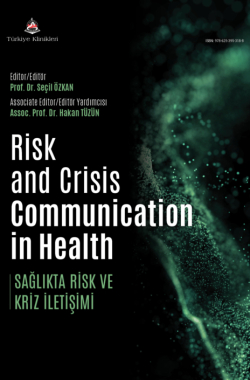Public Health Messaging and Media Relations
Asiye Çiğdem ŞİMŞEKa
aUniversity of Health Sciences Gülhane Faculty of Medicine, Department of Public Health, Ankara, Türkiye
Şimşek AÇ. Public health messaging and media relations. In: Özkan S, ed. Risk and Crisis Communication in Health. 1st ed. Ankara: Türkiye Klinikleri; 2024. p.33-41.
ABSTRACT
The first studies on public communication campaigns; It has been shown that mass media are more effective in raising awareness about an innovation and encouraging its dissemination, while interpersonal channels are more effective in encouraging adoption of the behavior. It is argued that interpersonal communication is more effective than mass communication because people perceive the former as more sincere than the latter. However, despite its known persuasive advantages, face-to-face interpersonal communication is not possible for large-scale public campaigns. The communication capacity of social media to affect public health is significantly high and increasing day by day. The popularity and technical sophistication of social media platforms may lead to more mainstream health discourse to an unprecedented extent. Rather than fighting emerging technologies, aligning technology with humanity’s interests and learning how to best use it will help promote better health and spread health-related information.
Keywords: Communications media; public health; social media
Kaynak Göster
Referanslar
- Lee EJ, Kim HS, Joo MH. Social media vs. mass media: mitigating the suspicion of ulterior motives in public health communication. Health Comm. 2023;38(11):2450-60. [Crossref] [PubMed]
- O'Sullivan PB, Carr CT, Masspersonal communication: a model bridging the mass-interpersonal divide. New Media & Society. 2018;20(3):1161-80. [Crossref]
- Moorhead SA, Hazlett DE, Harrison L, Carroll, JK, Irwin A, Hoving C. A new dimension of health care: systematic review of the uses, benefits, and limitations of social media for health communication. J Med Internet Res. 2013;15(4)e85:1-17. [Crossref] [PubMed] [PMC]
- Schillinger D, Chittamuru D, Ramírez AS. From "Infodemics" to health promotion: a novel framework for the role of social media in public health. AJPH. 2020;110(9):1393-6. [Crossref] [PubMed] [PMC]
- Jafar Z, Quick JD, Larson HJ, Venegas-Vera V, Napoli P, et al. Social media for public health: reaping the benefits, mitigating the harms. Health Promotion Perspective. 2023;13(2):105-12. [Crossref] [PubMed] [PMC]
- We Are Social Global Digital Report, January 2024. [cited: March 2024]. Available from: [Link]
- Spence PR, Lachlan KA, Westerman D, Spates SA. Where the gates matter less: ethnicity and perceived source credibility in social media health messages. The Howard Journal of Communications. 2013;24:1-16. [Crossref]
- Pagoto S, Waring ME, Xu R. A call for a public health agenda for social media research. J Med Internet Res. 2019;21(12):e16661:1-12. [Crossref] [PubMed] [PMC]
- Merchant RM, Güney EC, Lurie N. Public health messaging in an era of social media. JAMA. 2021;325(3):223-4. [Crossref] [PubMed]
- Cinelli M, Quattrociocchi W, Galeazzi A, Valensise CM, Brugnoli E, et al. The COVID 19 social media infodemic. Scientific Reports. 2020;10(1):16598. [Crossref] [PubMed] [PMC]
- Cinelli M, De Francisci Morales G, Galeazzi A, Quattrociocchi W, Starnini M. The echo chamber effect on social media. Proc Natl Acad Sci U S A. 2021; 118(9):e2023301118. [Crossref] [PubMed] [PMC]
- Gough A, Hunter RF, Ajao O, Jurek A, McKeown G, et al. Tweet for behavior change: using social media for the dissemination of public health messages. JMIR Public Health Surveill. 2017;3(1):1-17. [Crossref] [PubMed] [PMC]
- Cook CE. The History, Chemistry, and Regulation of Cosmetics. In: Chitra Chandrasekhar, ed. Wilkes Honors College of Florida Atlantic University, Bachelor of Science in Liberal Arts and Sciences. 2020.
- World Health Organization (WHO). Managing the COVID-19 Infodemic: Promoting healthy behaviours and mitigating the harm from misinformation and disinformation. [cited: February 2024]. Available from: [Link]
- Zenone M, Kenworthy N, Maani N. The social media ındustry as a commercial determinant of health. Int J Health Policy Manag. 2023;12:6840. [Crossref]
- Bruns A. Gatekeeping, gatewatching, real-time feedback: new challenges for journalism. Brazilian Journalism Research. 2011;7(2):117-36. [Crossref]
- Bruns A. Gatekeeping, gatewatching, real-time feedback: new challenges for journalism. Brazilian Journalism Research. 2014;10(2):224-37. [Crossref]
- Kaplan OU. Medya sağlık okuryazarlığında küresel ortaklık arayışları. İstanbul Ticaret Üniversitesi Sosyal Bilimler Dergisi. 2020;37(1):697-731.
- Randolph W, Viswanath K. Lessons learned from public healthmass media campaigns: marketing health in a crowded mediaworld. Annu. Rev. Public Health. 2004;25:419-37. [Crossref] [PubMed]
- Harmancı H. Sosyal medya ve halk sağlığı. Piyal B, editör. 21. Yüzyılda Halk Sağlığı: Değişen Dünya, Değişen Sorunlar. 1. Baskı. Ankara: Türkiye Klinikleri; 2019. p.84-8.
- Öntaş E, Özvarış ŞB. Sağlığı geliştirme ve medyada halk sağlığı savunuculuğu. Sağlık ve Toplum. 2021;31(1):23-30.
- Hoffman BH, Colditz JB, Shensa A, Wolynn R, Taneja SB, et al. #DoctorsSpeakUp: Lessons learned from a pro-vaccine Twitter event. Vaccine. 2021;(39):2684-91. [Crossref] [PubMed] [PMC]
- Vassallo AJ, Kelly B, Zhang L, Wang Z, Young S, Freeman B. Junk food marketing on Instagram: content analysis. JMIR Public Health Surveill. 2018;4(2): e54. [Crossref] [PubMed] [PMC]

